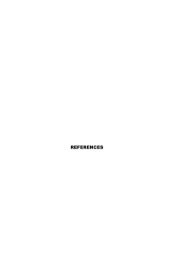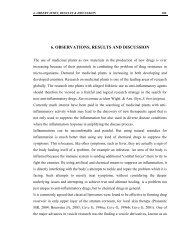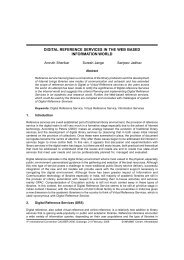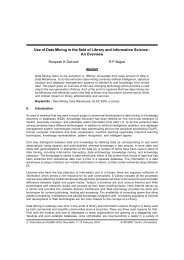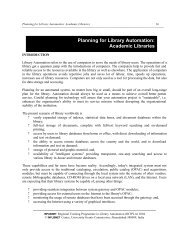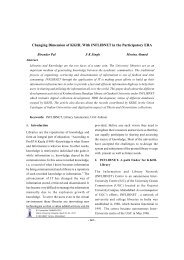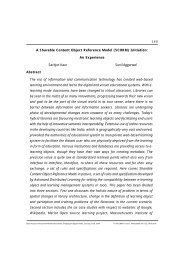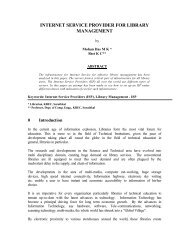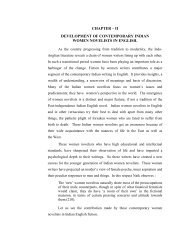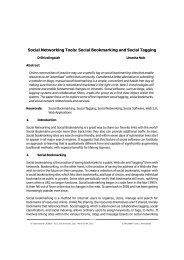Digital Rights Management and Libraries - DSpace@INFLIBNET ...
Digital Rights Management and Libraries - DSpace@INFLIBNET ...
Digital Rights Management and Libraries - DSpace@INFLIBNET ...
You also want an ePaper? Increase the reach of your titles
YUMPU automatically turns print PDFs into web optimized ePapers that Google loves.
242<br />
<strong>Digital</strong> <strong>Rights</strong> <strong>Management</strong> <strong>and</strong> <strong>Libraries</strong><br />
Mamatha Mallik<br />
Sonal Singh<br />
Abstract<br />
Content originators <strong>and</strong> publishers are employing <strong>Digital</strong> <strong>Rights</strong> <strong>Management</strong> (DRM) to<br />
protect the digital content by continuous replication <strong>and</strong> prevent the abuse of their intellectual<br />
property. However, locking the content <strong>and</strong> controlling operations on the content have<br />
presented interesting challenges in supporting fair use in the digital world. <strong>Libraries</strong> are not<br />
only purchasing intellectual property, but they are also producing <strong>and</strong> maintaining it. The<br />
article highlights the importance of DRM, its fair use issues, how to improve content delivery<br />
<strong>and</strong> its beneficial services for libraries. Electronic access.<br />
Keywords: <strong>Digital</strong> <strong>Rights</strong> <strong>Management</strong>, DRM, Content <strong>Management</strong><br />
0. Introduction<br />
Knowledge <strong>and</strong> information in the digital environments reveal a fast growth. The advent of new technology<br />
has opened new gates for a highly efficient mode of knowledge <strong>and</strong> information .This technological<br />
advancement has made this age/era a digital age/era. This digital age/information age has simply<br />
revolutionized the way workers work, institutional concepts, <strong>and</strong> also perhaps thinkers think. With the<br />
help of <strong>Digital</strong> media we can store information easily on computers as “data”, underst<strong>and</strong> information<br />
complexity, regularizes the information access <strong>and</strong> improves information environment. Now, internet<br />
forms the major concern <strong>and</strong> websites are the domains where the information is made available but So<br />
many questions arises like how to copyright the website, its content, source code, is downloading legal,<br />
viability of the user ID <strong>and</strong> password etc. to get the answer of all such questions, there is a need to<br />
underst<strong>and</strong> the concept of IPR.<br />
1. Intelelctual Property Right (IPR)<br />
Intellectual property is the creation of the human mind. A human being’s potential efforts to intellectual<br />
outcomes, which in turns have considerable value in economy. <strong>Rights</strong> associated with the intellectual<br />
property which gives legal protection is referred to as intellectual property rights. In the new era, with the<br />
development of the digitized information system, a new technology <strong>and</strong> the fair use relating to copyright<br />
are most affected.<br />
This technology is known as the DRM. DRM is meant by the <strong>Digital</strong> Right <strong>Management</strong>. The basic goal of<br />
the digital right management (DRM) is to develop <strong>and</strong> control the access of ‘’intellectual property’’. The<br />
present article throw light on the key components of the technology associated with DRM, how DRM has<br />
impacted content acquisitions by publishers <strong>and</strong> aggregators <strong>and</strong>, more especially, how best for libraries<br />
to support DRM as a necessary component of content access <strong>and</strong> redistribution.<br />
2. What is DRM<br />
The meaning of DRM could be different for the different users. It is a means of extending control on digital<br />
objects in cyberspace. DRM is being employed today to protect digital content (encryption), control specific<br />
operations on the content (play, print, copy, save) <strong>and</strong> to limit the number of times a particular operation<br />
may be exercised on the content (e.g. view three times). Most DRM technologies today ‘persistently<br />
2 nd Convention PLANNER - 2004, Manipur Uni., Imphal, 4-5 November, 2004 © INFLIBNET Centre, Ahmedabad
Mamatha Mallik <strong>and</strong> Sonal Singh<br />
243<br />
protect’’ content, that is, the content is never in a decrypted state - during storage, distribution or<br />
consumption, <strong>and</strong> applies to content downloads, as well as streaming content. Usage permissions<br />
must be obtained for a consumer to gain access to a DRM controlled digital file. These permissions are<br />
sometimes referred to as a key, permit or license, <strong>and</strong> may be obtained prior to receiving Collection<br />
management, Technology, Intellectual property, Acquisitions (library materials) Since digital content can<br />
be perfectly replicated <strong>and</strong> distributed infinitely, publishers <strong>and</strong> other content originators are employing<br />
DRM <strong>and</strong> persistent protection to prevent the abuse of their intellectual property.<br />
Now a days, locking the content <strong>and</strong> controlling operations on the content have become major challenges<br />
in supporting fair use in the digital world. Since libraries are the publishers, so, they not only purchase<br />
intellectual property but also produce <strong>and</strong> maintain it. By the use of DRM, library operations may be<br />
improved such as content delivery to the libraries as well as it also helps the publishers <strong>and</strong> content<br />
aggregators to improve their sell.one can underst<strong>and</strong> the improvement from this example as- the online<br />
retailer presents offers to the consumer, the consumer selection is made <strong>and</strong> supported by a shopping<br />
cart process, <strong>and</strong> a permit is issued to the consumer. The permit is unique to the consumer’s device <strong>and</strong><br />
includes the authorized usage rights (e.g. unlimited viewing, no printing); the key to provide access to the<br />
encrypted file, <strong>and</strong> it manages the download or stream of the content.<br />
For obtaining the permissions on the website location, most DRM technologies associated with an<br />
“Offer URL” having content objects. In the case of protected content being distributed via e-mail, the local<br />
software application first looks for a valid permit on the PC or device. If one does not exist, the software<br />
reads the offer URL <strong>and</strong> directs the user to a site to obtain one. Consumer choice is again exercised <strong>and</strong><br />
the transaction results in a permit being issued. Since the consumer already has the content, it does not<br />
require an additional download. Consumer awareness of usage permissions being granted varies from<br />
application to application. In a retail environment, it may be very obvious with the shopping cart metaphor<br />
being presented <strong>and</strong> a credit card being cleared. In a library setting, it may be very rightly with servers<br />
exchanging domain identifications <strong>and</strong> permits being issued. Software companies such as Adobe, IBM,<br />
InterTrust <strong>and</strong> Microsoft are advancing DRM technologies today. Supported file formats include text (LIT,<br />
OeB, PDF) <strong>and</strong> multimedia (MP3, MPEG-2, WMA).<br />
“Fair use” issues in the digital world Accordingly, national copyright laws in most countries incorporate<br />
exceptions for copying for personal use, research, education, archival copying, library use <strong>and</strong> news<br />
reporting, based on principles of “fair dealing”, or in the US, the doctrine of “fair Use”. The scope, strength<br />
<strong>and</strong> flexibility of these exceptions vary widely between countries <strong>and</strong> regions, in part due to differing<br />
national jurisprudence, but generally focus on the following conditions:<br />
The purpose <strong>and</strong> character of the use- copying must be for private, non-commercial<br />
purposes. Only single or a small number of copies may be reproduced.<br />
The proportion of the work that is copied should be made only of parts of the work. Complete<br />
works may be copied only where originals are not available in the market.<br />
Hard copy may typically be produced only by reprographic processes.<br />
The legal scholars, politicians <strong>and</strong> copyright owners agree that fair use is hard to underst<strong>and</strong> <strong>and</strong> it fails<br />
to provide effective guidance for the use of other works today. Library <strong>and</strong> information centers have right<br />
of fair use under copyright laws (legalised by many governments). Certain illustrations have been included<br />
to ascertain potential fair users under copyright law. Four factors must be taken into account in analyzing<br />
whether the use is fair or not in copyright law.
244<br />
<strong>Digital</strong> <strong>Rights</strong> <strong>Management</strong> <strong>and</strong> <strong>Libraries</strong><br />
The four factors for analyzing fair use include:<br />
Character of use<br />
Amount <strong>and</strong> importance of the part copied<br />
Nature of the material to be copied<br />
Effect on market for permission.<br />
Since digital content can be perfectly replicated <strong>and</strong> distributed infinitely, publishers <strong>and</strong> other content<br />
originators are employing DRM <strong>and</strong> persistent protection to prevent the abuse of their intellectual property.<br />
However, locking the content <strong>and</strong> controlling operations on the content have presented interesting<br />
challenges in supporting fair use in the digital world. For instance, most DRM technologies today bind<br />
the content object to a specific device (PC, PDA, mobile device). This is usually a one-for-one relationship,<br />
that is, the PDF can only be read on the PC it was downloaded to, or the MP3 may only be played on one<br />
specific mobile device. Protected digital content changes the rules of physical world fair use because we<br />
transport our books from the library to home <strong>and</strong> to the office. We lend our books to friends <strong>and</strong> family. We<br />
play our music CDs on our PCs at home <strong>and</strong> at work, in the home entertainment center, as well as in our<br />
vehicles. Content providers <strong>and</strong> DRM technology companies are experimenting with various forms of<br />
digital fair use, but the end result is not clear. Library content <strong>and</strong> technology Providers, such as NetLibrary<br />
<strong>and</strong> Baker & Taylor, are tackling the issues in the digital libraries.<br />
3. Beneficial Services for <strong>Libraries</strong><br />
<strong>Libraries</strong> leverage a variety of services as part of content delivery to customers, especially materials<br />
acquisition <strong>and</strong> document delivery. Materials providers, especially publishers <strong>and</strong> book wholesalers,<br />
have increased ‘’print on dem<strong>and</strong>’’ offerings. These services, in addition to the more traditional methods<br />
for acquiring content, increase positively a library’s ability to meet user needs. A recent ‘’pay per view’’<br />
service comes from OCLC. Library <strong>and</strong> information centers are required to perform library copying for<br />
patrons <strong>and</strong> for its own collection; reserve room operations (print copies), electronic copies, audiovisual<br />
copies, news programme <strong>and</strong> contractual limitations on acquisition <strong>and</strong> inter library loan; all these<br />
involves copyright issues. These operations are necessary to run normal activities of the libraries,<br />
information <strong>and</strong> documentation centers. In the digital environment, now, these traditional services are<br />
replaced by FirstSearch services. This is a service that could have benefited from DRM to improve the<br />
usability of the content <strong>and</strong> specially the administrative burden for libraries. Now, FirstSearch services<br />
subscribers are able to purchase articles from the Electronic Collection Online (ECO) collection as<br />
OCLC announced in July 2001.<br />
The goal of this service is to provide libraries the option of article-level content delivery to patrons through<br />
the ECO service, while not ommitting the library to a full subscription to e-journals. This proves especially<br />
useful for back file content or little used titles. A subscription to the OCLC FirstSearch ECO service is<br />
required. Users may retrieve the full image of the activated article through the ECO collection archive in a<br />
variety of formats such as PDF <strong>and</strong> HTML. By the help of DRM, <strong>Libraries</strong> purchase e-books from netLibrary,<br />
may catalog those titles <strong>and</strong> make them available directly from the library’s automation system, or<br />
provide access though the library Web site. NetLibrary has implemented a number of safeguards to<br />
protect the intellectual property rights associated with the e-book content. netLibrary prevents the user<br />
from having continued access to the service for a period of time. Under the current property rights<br />
agreements, only one copy of content may be used at one time. If a library wants to provide simultaneous<br />
access to a title, multiple copies must be purchased with print. <strong>Libraries</strong> may work with netLibrary to<br />
determine the length of time an e-book may circulate. Once the circulation period has expired, access to<br />
the e-book is deactivated. There is the need to go for the checkout procedure for a patron, If he wants to<br />
“borrow’’ the title again. In the netLibrary model of distribution <strong>and</strong> access, rights of use of digital content<br />
are specified <strong>and</strong> managed through the DRM technology.
Mamatha Mallik <strong>and</strong> Sonal Singh<br />
245<br />
4. Conclusion<br />
<strong>Digital</strong> right management is essential for human creativity. Under this system of rights, creators are<br />
assured that their works cannot be copies anywhere. Digitizing <strong>and</strong> using copyright work in IT environment<br />
require this technology. DRM should focus for growth, economic progress of individuals <strong>and</strong> institutions<br />
<strong>and</strong> contribute in the increment of knowledge, culture <strong>and</strong> information exchange all over the world.<br />
5. References<br />
1. Krishan, A.S.A <strong>and</strong> Chakravarti, A.K. Intellectual property rights in the ensuing global digital<br />
economy. Electronics information <strong>and</strong> planning. 24 (11): 618-25,1997.<br />
2. Intellectual property rights. Edited by Debroy, Bivek. New Delhi: B R Publishing, 1998.<br />
3. Kumar, A. Trademarks, copyrights <strong>and</strong> patents. New Delhi: Singhal Publications,1997.<br />
4. Seadle, M. Copyright in the networked world: Spoken words. Library Hi Tech, 18 (1) 2000.<br />
p.102-106.<br />
5. Mittal, D.P.: Law of IT (Cyber law). Delhi: Texman, 2000.<br />
6. Samuelson, Pamela, “Copyright <strong>and</strong> <strong>Digital</strong> <strong>Libraries</strong>.” Communications of the ACM 38, no.<br />
3 (April 1995): 15-21, 110.<br />
About Author<br />
Dr. Mamta Mallik holds Ph.D. in Library Science. Presently she is working as a<br />
guest Lecturer in Vikram University, Ujjain <strong>and</strong> she has presented number of papers<br />
in seminar <strong>and</strong> conferences. She is a member of professional associations.<br />
Dr. Sonal Singh is M.Sc. (Zoology), M.Lib.Sc., B.Ed., B. Mus., Ph.D. (Library Science),<br />
P.G.D.C.A. <strong>and</strong> is working as Senior Lecturer in School of Studies in Library &<br />
Information Science, Vikram University, Ujjain. She has also worked as Librarian at<br />
Kendriya Vidyalaya, Ujjain for seven years. She has a teaching experience of over<br />
twelve years. She is a Life Member of ILA, IATLIS <strong>and</strong> IASLIC <strong>and</strong> has attended a<br />
number of conferences. She has contributed more than forty articles to library sceince<br />
journals of repute. She has authored three books <strong>and</strong> edited one book.



